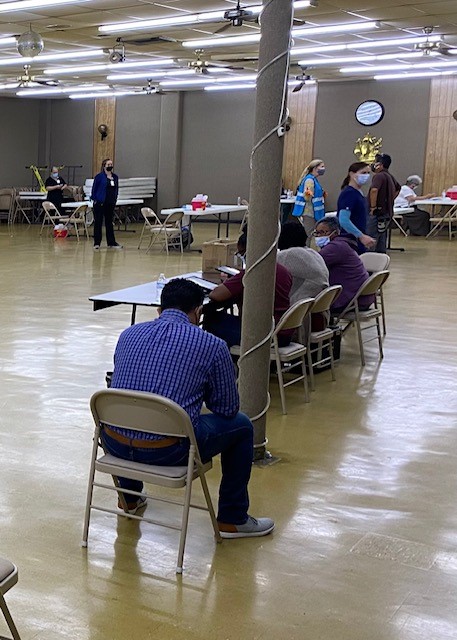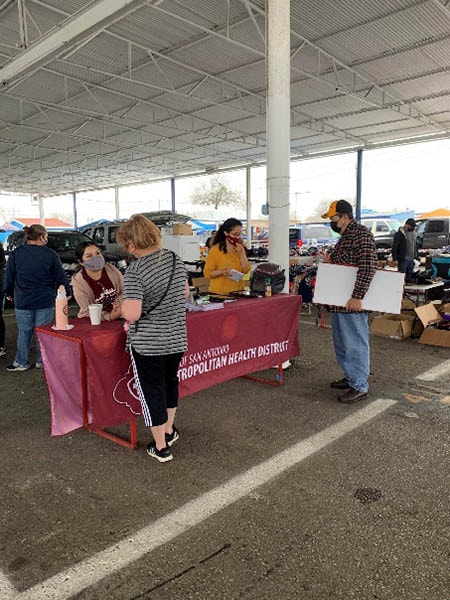Mobile Vaccination Clinics Help San Antonio Residents Get COVID-19 Vaccine and Fight Vaccine Hesitancy
Texas is the second most populous state in the United States, with a population of just under 30 million people. As of December 1st, 2021, 54% of Texas residents eligible to receive the COVID-19 vaccine had been fully vaccinated, and 64% of Texans eligible to receive the COVID-19 vaccine had received at least one dose. In comparison to the rest of the country, 60% of the population has been fully vaccinated while 71% of the population has received at least one dose.
San Antonio is the seventh most populous city in the United States and the second biggest city in Texas. The city has been working tirelessly to make sure residents have fair and just access to COVID-19 vaccination. San Antonio’s population is approximately 1,487,000 people and 64% of the population identifies as Hispanic or Latinx while about 25% identifies as white, and 6% identifies as black or African American. According to Carlos V. Rodriguez, the manager of the Office of Health Equity for San Antonio Metropolitan Health District, as of the middle of November 2021, about 94% of eligible San Antonio residents ages 12 years and older received at least one dose of the COVID-19 vaccine, and nearly 78% are fully vaccinated.

People waiting for a vaccine at a mobile vaccine clinic event.
When COVID-19 vaccines became available, San Antonio residents could go to a clinic, doctors office, or multi-purpose stadium that had a drive-thru clinic. These sites vaccinated 3,000 to 4,000 people daily. However, Rodriguez recognized mass vaccination sites alone would not suffice in terms of getting the maximum amount of people vaccinated. “We clearly noticed that fewer people were coming into the three mass vaccination sites established in the city at the time we initiated the expansion of our mobile clinics in communities that have become marginalized.”. When the implementation of mobile vaccine clinics by Metro Health started, we were giving vaccines by appointment only because we wanted to control physical distancing,” commented Rodriguez. As a result, San Antonio Metro Health increased their efforts making the COVID-19 vaccine easily available for communities all over the city. Their first mobile vaccination clinic opened near the end of April 2021.
San Antonio was able to expand their network of vaccination clinics and as a result get more people vaccinated by using a hybrid approach that included both mass vaccination sites and mobile clinics. The mass vaccination sites served people who had transportation and were physically able to come to the sites, while the mobile clinics served people who had no transportation. This hybrid model acknowledged the need to reach more communities that have been marginalized. To expand the mobile clinics, San Antonio Metro Health partnered with University of Texas Health, the University of Texas Health Science Center, the University of Incarnate Word School of Nursing, Wellmed, and CentroMed and established more than 600 mobile vaccination clinics.
To find out which communities needed the mobile vaccination clinics, San Antonio Metro Health coordinated with the city to establish a map that identified target areas using geographic information systems. Data such as race, income, level of community transmission, and mortality, along with the percentage of the population being vaccinated, was gathered based on ZIP code. To find this data, San Antonio Metro Health coordinated with the city and mapped the areas through the geographic information system. Since all vaccination data was being compiled in a general registry there was no way to separate the information specific from mobile clinics. To be able to target the vaccination in marginalized communities we utilized our Equity Atlas that has data with census tracks with higher levels of people of color and low income and we added the rates of infection, mortality, and levels of vaccination by zip code.
To reach populations in need of assistance, the San Antonio Metropolitan Health District partnered with more than 80 community churches and community-based organizations. Rodriguez says, “Working with churches and community-based organizations has been rewarding and successful.” With more than three quarters of the eligible population vaccinated with at least one dose, Metro Health will continue to provide support to the district’s communities until that support is no longer needed. Rodriguez is proud of the accomplishments that have been made in the past few months. “Continuing to build partnerships has proven successful, along with the work with the communities that have been marginalized.”

Community health workers at a flea market registering people for vaccination.
In addition to successes, San Antonio faces challenges, including increasing homelessness. Homeless encampments are banned, and that coupled with the end to the federal eviction moratorium and rising home costs are increasing those challenges. Vaccinating people experiencing homelessness is important and the city is taking steps to improve the situation. The Department of Health is working with Haven for Hope, a community-based organization, to assist people in need of vaccination. The goal is to administer the vaccine to those who normally wouldn’t have access to it or may not have a primary healthcare provider. They are also working with churches who have members who may be experiencing homelessness.
While tremendous strides have been made in the past few months to get people vaccinated, Rodriguez says the demand has decreased significantly. He attributes this to vaccine hesitancy.
Rodriguez says some San Antonio residents are hesitant to get vaccinated because of political reasons, mistrust of government, misinformation from the internet, and concern about the quick development of the vaccine and possible long-term effects.
A great deal of effort is being put into improving vaccine confidence by community health workers who are in the community every day. These workers received information on COVID-19 vaccinations from the CDC that they can provide to community members. This information also helps community health workers facilitate conversations with people who are vaccine hesitant. “We aren’t necessarily trying to force anybody to get vaccinated,” Rodriguez says. “We just meet the people where they are and provide simple facts.” The Health Department recently developed a flyer about some of the myths that are circulating about the vaccine, hoping it will encourage more people to get vaccinated.
Metro Health is also offering financial incentives to people who haven’t gotten vaccinated. On September 24, 2021, Metro Health began offering $100 gift cards to increase the number of fully vaccinated people in the city of San Antonio and Bexar County.
When asked to sum up this year, Rodriguez says he’s most proud of the mobile vaccine clinics that allowed San Antonio to reach communities that have been marginalized with low vaccination rates. ZIP codes where less than 50% of the population has been vaccinated are the ones where San Antonio Metro Health works to increase the number of mobile clinics. “The mapping methodology we developed to target the groups that have been marginalized based on data and the partnerships we established is what allowed us to be successful.” As of the first week of November 2021, almost 26,000 doses have been administered through the mobile clinics.
There are also lessons to be learned from the pandemic. Rodriguez says if there’s a future pandemic, he hopes everyone has the same access to a vaccine. “We have to push for equity. At the very beginning, I wouldn’t say San Antonio’s response was incorporating an equity lens, and some of us were really pushing for that …Technology must continue to be utilized as a tool to develop mapping to target areas that still need our help.”
What are you, your health department, or your organization doing to support COVID-19 vaccination in your community? Share your story with communityfeatures@cdc.gov and you could see it on our COVID-19 Vaccine Community Features page.